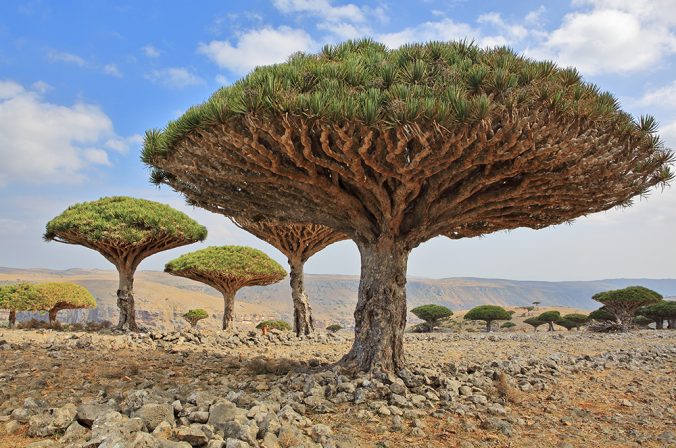Eerie demeanour heightened by the tear drops of translucent blood-red resin that ooze from wounded limbs.
Very trendy across Sydney, and as dear as poison the Dragon’s Blood tree is a cross somewhere between spectacular and bizarre.
Endemic to the Yemeni island off Socotra, near the Horn of Africa Dragon’s Blood (Dracaena cinnabari) trees have an eerie, prehistoric aspect. Their bizarre shape, like umbrellas blowing inside-out, helps them to survive on the arid, thin soil that covers the island’s granite mountains and limestone plateaus. Rainfall is rare, but occasional mist condenses and runs down to its branches that slope downwards, directing tiny trickles of water towards the trunk and eventually the roots.
The large, packed crown also provided shade and reduce evaporation. This shade also aids in the survival of seedlings growing beneath the adult tree, explaining why the trees tend to grow closer together.
Dragon’s Blood eerie demeanour is heightened by the tear drops of translucent blood-red resin that ooze from wounded limbs. Local residents encourage the flow by carefully incising the bark or prising apart existing fissures and returning later to collect droplets and small chunks of resin. As much as half a kilogram can be harvested from a single tree. Heated, dried and formed into small slabs that have the creepy, powdery quality of dry blood. It is also thought that the dye ‘dragon’s blood’ was responsible for the intense colour of Stradivarius violins.
In seventeenth century Europe this strange ‘dragon’s blood’ was tinged with magic and prized as a cure-all. It was prescribed for serious conditions and was also a reassuringly expensive ingredient in love potions and breath-fresheners. Now we know that the resin contains anti-microbial and anti-inflammatory compounds. It is still use locally as a mouthwash and treat rashes and sores.
Precious dragon’s blood was tinged with magic and prized as a cure-all and an expensive ingredient in love potions and breath-fresheners.
Why Dragon’s Blood? Socotra was an important stop on trading routes between India, the Middle East and the Mediterranean, and the origin probably lies with Indian merchants who brought the resin to market along with their Hindu myths. One of these involved a legendary fight in Socotrian soil between an elephant and a dragon during which the dragon gulped the elephant’s blood before being squashed in the melee spilling the blood of both animals.
In the first century AD the story reached a wider audience. Some 2000 years later the scientific name Dracaena derives from the Greek for female dragon and the resin is called ‘dragon’s blood’ and many languages.
Dragon’s Blood trees usually produce flowers around March that tend to grow in small clusters of fragrant, white, or green flowers at the end of the branches. The fruits are described as a fleshy berry, which changes from green to black as it gradually ripens. The fleshy berry fruit ends up being an orange-red colour that contains one to three seeds.
Dragon’s Blood trees have been economically important for centuries. Local people value it as food for livestock – feeding very small quantities of berries to cows and goats to improve their health.
